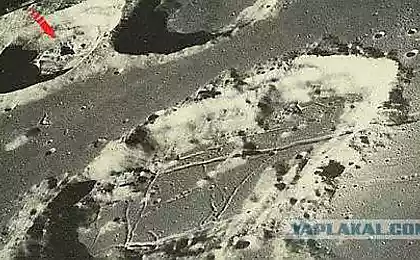690
The other side of the Earth
March 28, 2013.
Siklyuk (Island Yttygran) - Harbor Glasenapp (Island Arakamchechen)
I woke up at four-thirty, on that cold. Tormented half asleep to 6 rose. Serge general ZYAB all night and could not sleep properly. I measure the temperature -9 C0. Cold limbs, than the day before, but we happened to -25 C0 slept quite comfortably. The cause of our wretchedness, I realized, when I decided to go out. It turns Serge evening did not close before the end of the tent and the floor was pulling draft. Fortunately something else at my feet was a jacket that somehow restrained the tent "Khius." After breakfast we go to inspect the Whale Alley and set the flag.
29 photos via basov-chukotka

2. Man is not dedicated to the history of Inuit culture for the first time saw the Whale Alley, never believe that the whale jaws dug into the ground is a historical monument and have the same meaning in the history of north-eastern Eurasia, like Stonehenge or the pyramids of Egypt. Like the more famous historical monuments of world importance Whale Alley asks more questions than it answers.
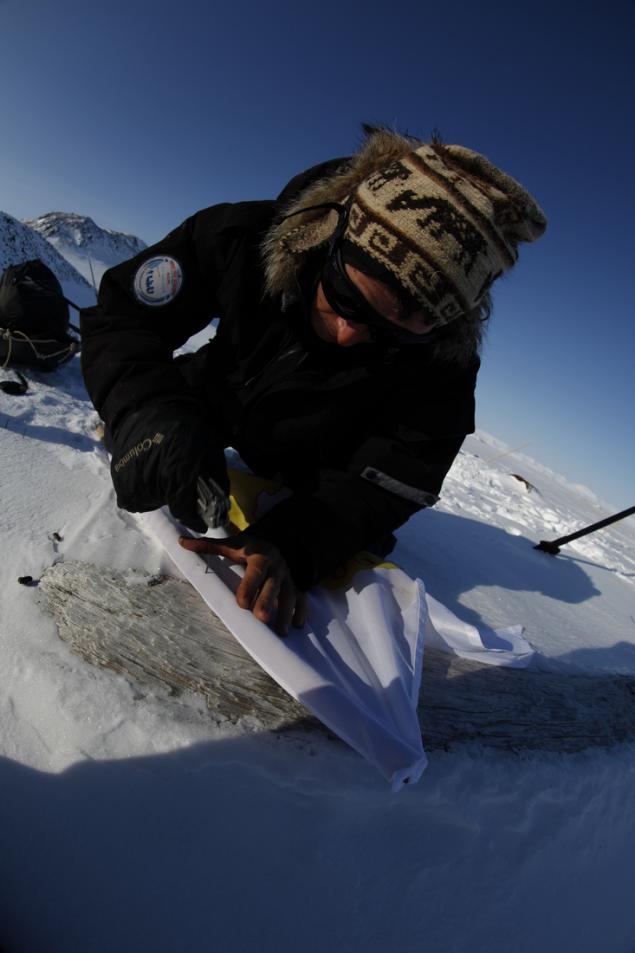
3. Whale Alley. On the history issue.
Huskies - is the most northerly in the world of people living in the vast space tsirkumpolrnom from Greenland to Eastern Chukotka. The history of Eskimo culture, scientists can trace the past four millennia, and divide it into several archaeological periods:
1) Old Bering Sea - hunting walrus and seals, to the VIII century BC;
2) Punuk - marked predominance of whaling, from the VIII to XIII-XV century;
intermediate culture birnik existed mainly in Northern Alaska;
3) Tula - hunting for small pinnipeds, XV-XVIII century. The era of the Little Ice Age;
4) "historical" era - c XVIII century of European contact, the use of metal tools and firearms.
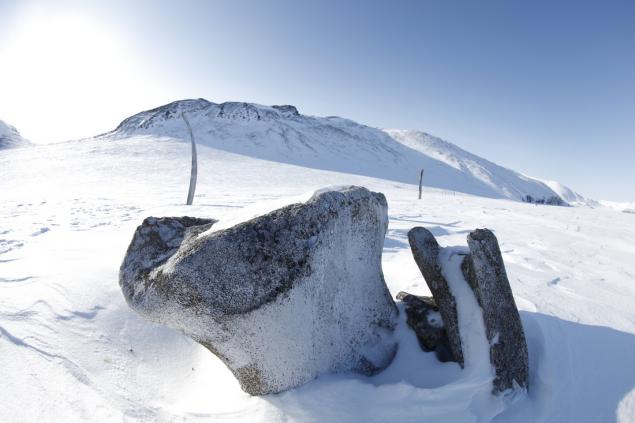
4. zenith Eskimo culture reached near the northern berinogomorya, due to the wealth of the region's biological resources. But even in the most favorable conditions in the north of the region have not formed Obshcheplemennaja Inuit associations as for example, the North American Indians. The reason for this was the absence of the surplus product. Simply put, to form at least a rudimentary form of government requires that a hunter was able to provide food several families. In this case, people, men, freed from the constant concern to forage could organize ranegosudarstvennye institutions of power: the army, the religious and ceremonial buildings, large settlements.
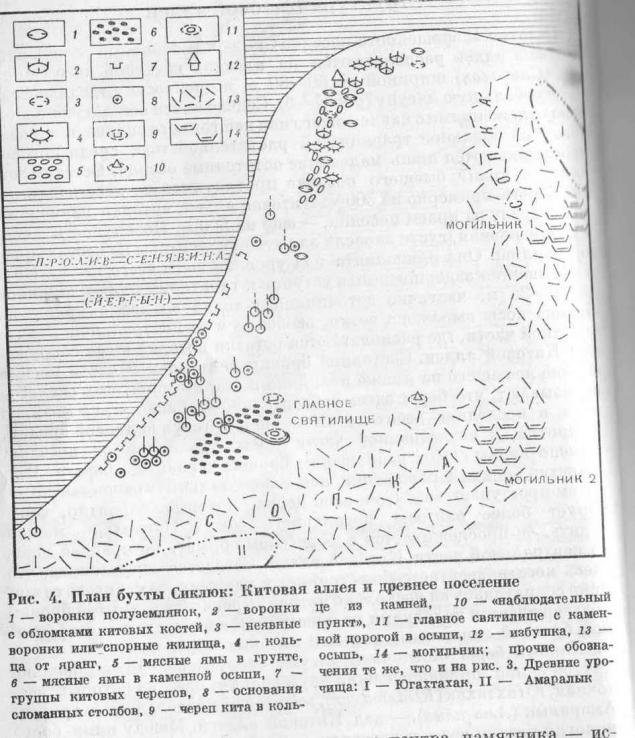
5. Eskimo settlements - are mainly small poselochki up to 50 people, composed of relatives that were located throughout the east coast of the Chukchi Peninsula. The most coveted prey each settlement - a whale. However, whaling activity is very dangerous and requires a minimum of 30 to 60 people. So the hunt for large bowhead whale was carried out residents of several settlements.
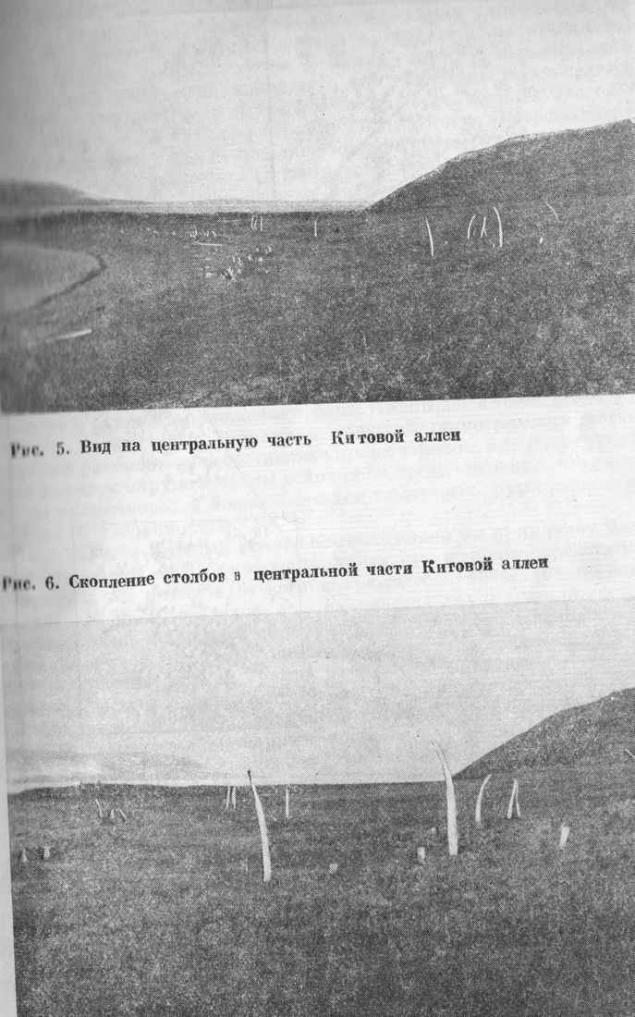
6. Against the background of this history in the 14-15 centuries, during the beginning of the decline of culture Punuk on the island Yttygran created cult construction of at least 34 of the jaws of the whale. Jaws 5 meter height vertically buried in the ground in groups of 2-3 pieces. Together with its jaws buried on the banks of whale skulls and arranged on a hill meat pits for a short storage myasa.Ves the religious complex was set on neutral territory, where at that time there was not a large settlement.
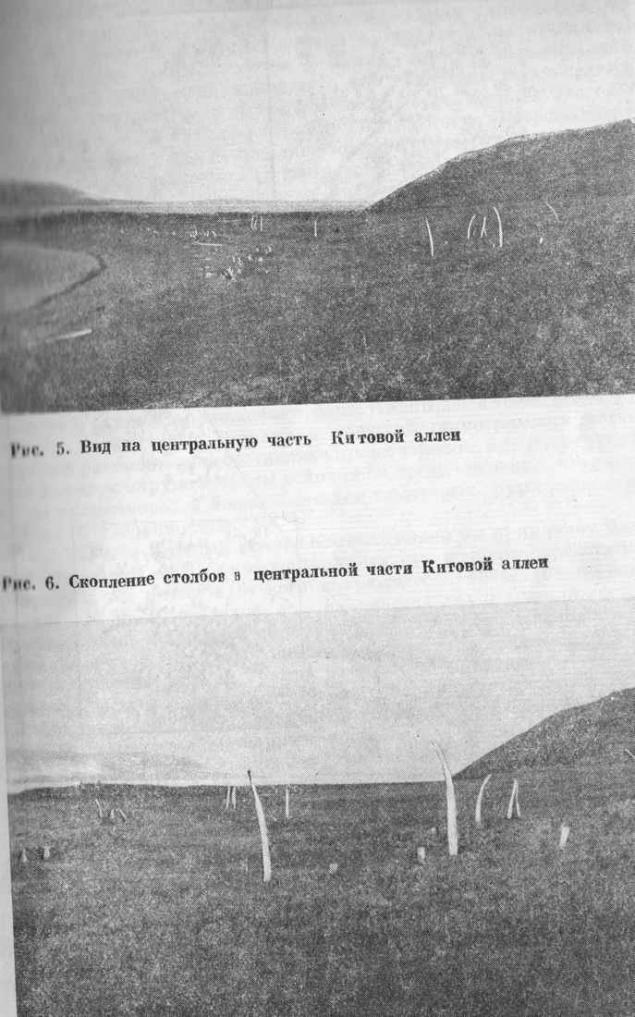
7. historical reconstruction, which is offered by archeology, history Bering Sea Eskimo as follows:
In the early onset of the Little Ice Age winters became tougher whaling declined sharply, due to which there was a threat of famine and devastation of settlements. This issue has touched not only the Asian Eskimos, but also American. Increased in favorable climatic period of the region's population beginning to experience an acute need in the search for mining sites marine mammals. This leads to wars and armed conflicts. It was during this period in eastern Chukotka created a political-military alliance Inuit hunters The hunters united Eskimo settlement of Mechigmen Bay to Ungazika. To maintain the union, created a religious-ideological base in the form of the sacred monument on the island Yttygran, which annually from each of the settlements visited by representatives of the Asian Eskimo settlements. Gathering was supposedly in the late summer and early autumn, when there is a "window" in the business. Charges were exclusively male, which committed ritual sacrifices at the temple, then a decisive military and political problems. On the island at the time of such charges, the participants brought with them the jaw and skull bowhead whales and creating meat pits. By the way, the weight of each jaw is approximately 300 kg. Slightly less weighs skull.
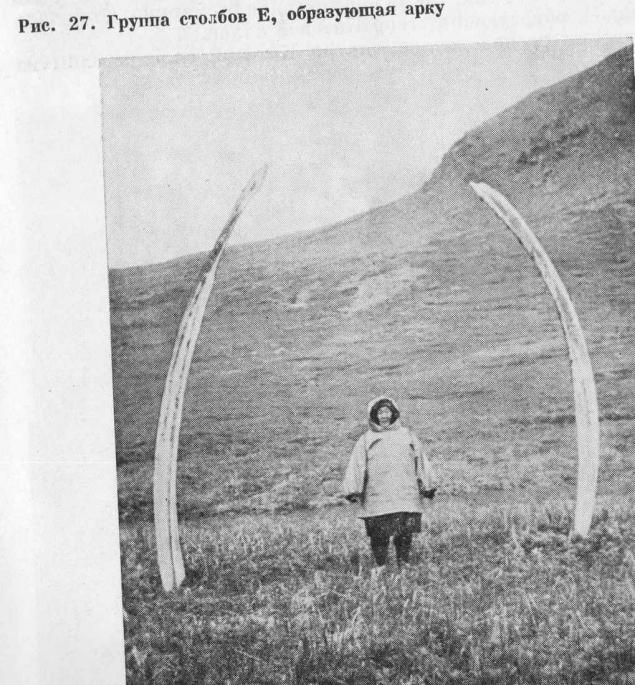
8. Approximately looks historical reconstruction of events XIV-XV centuries on the territory of the northern Bering Sea. And then there are two key questions - why and why? Why Asian Eskimos created Whale alley? And why the memory of such a colossal event completely erased from the people?

9. At the beginning of the twentieth century, for example, the "pillars" were used as targets for zeroing rifles and how to knit boats bollards and later boats. Not even the mythological material remained clothed in legends and stories. Tradition tells of this region Yttygran mentioned as the scene of the magical adventures of the hero and the abode of mythical creatures, such as the Mistress of the Sea - Mygym Agna.

10.

11. In total, archaeologists study whales alley at the end of the 1970s, discovered the remains of 34 "pillars" of the jaws of the whale, 50 skulls of meat and about 150 wells. Of this number of columns in the late 1970s, archaeologists have counted only 13 survivors. We found only 7 of entire jaws.
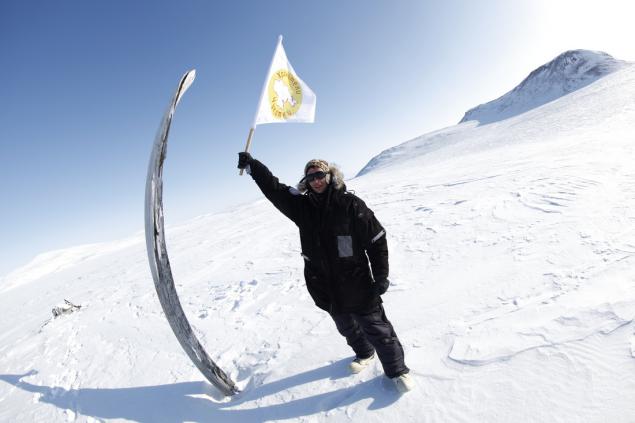
12.
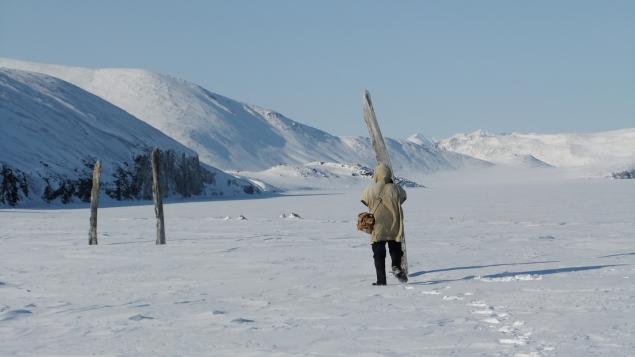
13.
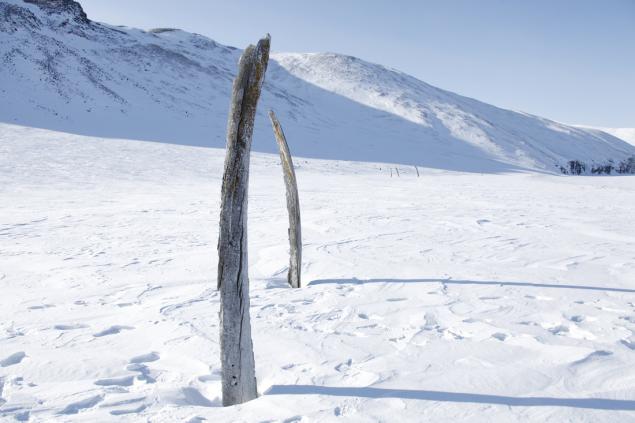
14. After a photo session and filming we identified point flag setting - nearby hill above the alley - Amaralyk. On a hill with a spectacular view of the entire braid Singahak on which the whale alley, an abandoned village Siklyuk and our base camp.

15.
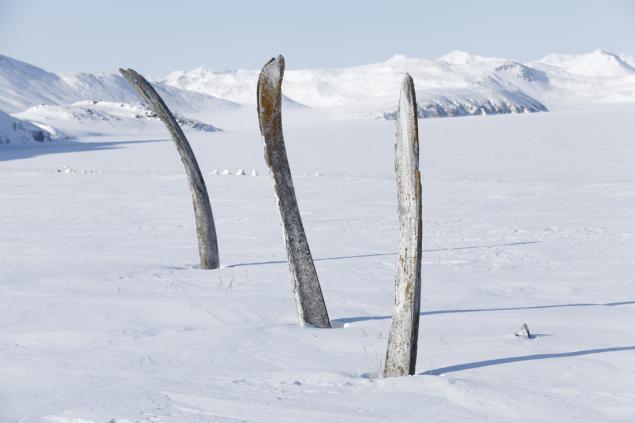
16.

17.
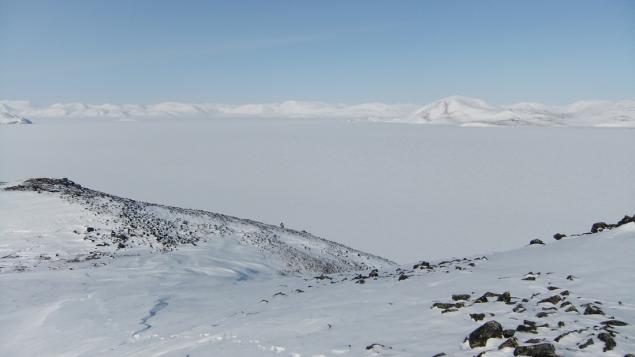
18. The weather favored us again: no wind, temperature - 22 C0, but the cold is not felt by active warming April sun.

19.
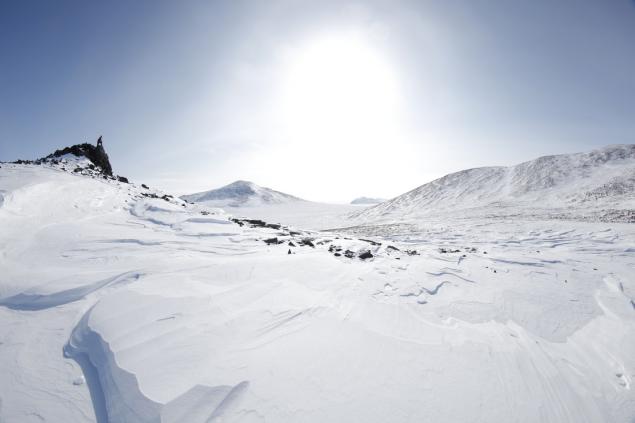
20.

21.

22. After completing all planned activities on Yttygrane, dine, we remove the camp, and move through the strait Yarga, the opposite island Arakamchechen.
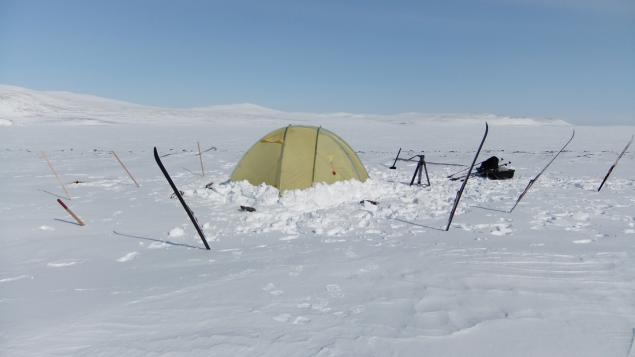
23.
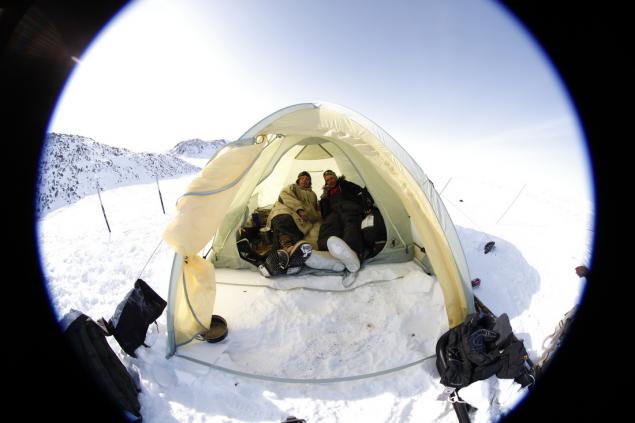
24.

25. Near the island did not start strong, but extremely unpleasant drifting snow. Leaving the scraper on the shore, we go in search of the beam, which must be located on the map indicated by oblique Chukchi toponym Myergyn adapted to local population resounding Yarga. At the base of the spit, we found two more pillars (one is, the other is filled up). Snow on the spit in fact. It becomes especially clearly understand the meaning of the saying about those who go skiing in the summer. But walking on the tundra on skis is not the silly exercise, how to go to them on the ice of streams and lakes. In this case, fully revealed the meaning is another proverb - "like a cow on ice". Full helplessness. Coupled with a fresh wind control on the icy crossing was as close as possible to zero. Startling the fox, which climbed to almost vertical slope of curious on two eccentrics waltzing we went skiing in a cozy cove on the bank which stood beams.
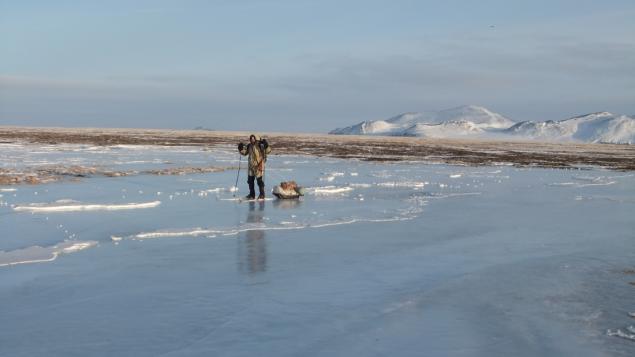
26. "After a fairly quiet cold night, we went early in the morning (August 1) to the west along the south side of the island and 1 mile from the Cape Pagelyan found a good harbor, named for my assistant warrant officer Glasenapp, describes it. At this point, there is a village called Iergin. We need to be measured then the base [base] up to the Chukchi yurts: even this is not aroused no suspicion of the Chukchi, who themselves still hard to us the work of our help. »
FP Litke "Travelling around the world on the sloop" Senyavin "1828.

27. Bullock, as might be expected, was in a very sad state. Window embossed, inside is full of snow. Penetrating into the beams through the window we have to our surprise and delight found a bag of coal and furnace in good condition. The roof is, the furnace has a rest - a trick. Drag and spit our things we do ennoblement Beam improvised. After cleaning the snow from the beams, which is due to the strong winds here is more like a stone, we are "glazed" propylene bag window and lit the stove. And it was very useful, because in the afternoon the wind had increased to 8 m / s.

28. After dinner, watch a "movie." Video Camera "SONY" HXR-NX30P, which we filmed our video has a stunning setting - image projection. Sitting comfortably on the benches, under the howling wind outside the wall look at our bar videoopusy. Full sur.
Gone for the day of 15 km. t -19 C0, wind 8 m / s
Posted in [mergetime] 1366622308 [/ mergetime]
29. Photographs of the author, Sergey Gavrilenko, as well as from the book "Whale Alley"
___
All
PS: sorry messed up a little bit with the text ...

Source:
Siklyuk (Island Yttygran) - Harbor Glasenapp (Island Arakamchechen)
I woke up at four-thirty, on that cold. Tormented half asleep to 6 rose. Serge general ZYAB all night and could not sleep properly. I measure the temperature -9 C0. Cold limbs, than the day before, but we happened to -25 C0 slept quite comfortably. The cause of our wretchedness, I realized, when I decided to go out. It turns Serge evening did not close before the end of the tent and the floor was pulling draft. Fortunately something else at my feet was a jacket that somehow restrained the tent "Khius." After breakfast we go to inspect the Whale Alley and set the flag.
29 photos via basov-chukotka

2. Man is not dedicated to the history of Inuit culture for the first time saw the Whale Alley, never believe that the whale jaws dug into the ground is a historical monument and have the same meaning in the history of north-eastern Eurasia, like Stonehenge or the pyramids of Egypt. Like the more famous historical monuments of world importance Whale Alley asks more questions than it answers.

3. Whale Alley. On the history issue.
Huskies - is the most northerly in the world of people living in the vast space tsirkumpolrnom from Greenland to Eastern Chukotka. The history of Eskimo culture, scientists can trace the past four millennia, and divide it into several archaeological periods:
1) Old Bering Sea - hunting walrus and seals, to the VIII century BC;
2) Punuk - marked predominance of whaling, from the VIII to XIII-XV century;
intermediate culture birnik existed mainly in Northern Alaska;
3) Tula - hunting for small pinnipeds, XV-XVIII century. The era of the Little Ice Age;
4) "historical" era - c XVIII century of European contact, the use of metal tools and firearms.

4. zenith Eskimo culture reached near the northern berinogomorya, due to the wealth of the region's biological resources. But even in the most favorable conditions in the north of the region have not formed Obshcheplemennaja Inuit associations as for example, the North American Indians. The reason for this was the absence of the surplus product. Simply put, to form at least a rudimentary form of government requires that a hunter was able to provide food several families. In this case, people, men, freed from the constant concern to forage could organize ranegosudarstvennye institutions of power: the army, the religious and ceremonial buildings, large settlements.

5. Eskimo settlements - are mainly small poselochki up to 50 people, composed of relatives that were located throughout the east coast of the Chukchi Peninsula. The most coveted prey each settlement - a whale. However, whaling activity is very dangerous and requires a minimum of 30 to 60 people. So the hunt for large bowhead whale was carried out residents of several settlements.

6. Against the background of this history in the 14-15 centuries, during the beginning of the decline of culture Punuk on the island Yttygran created cult construction of at least 34 of the jaws of the whale. Jaws 5 meter height vertically buried in the ground in groups of 2-3 pieces. Together with its jaws buried on the banks of whale skulls and arranged on a hill meat pits for a short storage myasa.Ves the religious complex was set on neutral territory, where at that time there was not a large settlement.

7. historical reconstruction, which is offered by archeology, history Bering Sea Eskimo as follows:
In the early onset of the Little Ice Age winters became tougher whaling declined sharply, due to which there was a threat of famine and devastation of settlements. This issue has touched not only the Asian Eskimos, but also American. Increased in favorable climatic period of the region's population beginning to experience an acute need in the search for mining sites marine mammals. This leads to wars and armed conflicts. It was during this period in eastern Chukotka created a political-military alliance Inuit hunters The hunters united Eskimo settlement of Mechigmen Bay to Ungazika. To maintain the union, created a religious-ideological base in the form of the sacred monument on the island Yttygran, which annually from each of the settlements visited by representatives of the Asian Eskimo settlements. Gathering was supposedly in the late summer and early autumn, when there is a "window" in the business. Charges were exclusively male, which committed ritual sacrifices at the temple, then a decisive military and political problems. On the island at the time of such charges, the participants brought with them the jaw and skull bowhead whales and creating meat pits. By the way, the weight of each jaw is approximately 300 kg. Slightly less weighs skull.

8. Approximately looks historical reconstruction of events XIV-XV centuries on the territory of the northern Bering Sea. And then there are two key questions - why and why? Why Asian Eskimos created Whale alley? And why the memory of such a colossal event completely erased from the people?

9. At the beginning of the twentieth century, for example, the "pillars" were used as targets for zeroing rifles and how to knit boats bollards and later boats. Not even the mythological material remained clothed in legends and stories. Tradition tells of this region Yttygran mentioned as the scene of the magical adventures of the hero and the abode of mythical creatures, such as the Mistress of the Sea - Mygym Agna.

10.

11. In total, archaeologists study whales alley at the end of the 1970s, discovered the remains of 34 "pillars" of the jaws of the whale, 50 skulls of meat and about 150 wells. Of this number of columns in the late 1970s, archaeologists have counted only 13 survivors. We found only 7 of entire jaws.

12.

13.

14. After a photo session and filming we identified point flag setting - nearby hill above the alley - Amaralyk. On a hill with a spectacular view of the entire braid Singahak on which the whale alley, an abandoned village Siklyuk and our base camp.

15.

16.

17.

18. The weather favored us again: no wind, temperature - 22 C0, but the cold is not felt by active warming April sun.

19.

20.

21.

22. After completing all planned activities on Yttygrane, dine, we remove the camp, and move through the strait Yarga, the opposite island Arakamchechen.

23.

24.

25. Near the island did not start strong, but extremely unpleasant drifting snow. Leaving the scraper on the shore, we go in search of the beam, which must be located on the map indicated by oblique Chukchi toponym Myergyn adapted to local population resounding Yarga. At the base of the spit, we found two more pillars (one is, the other is filled up). Snow on the spit in fact. It becomes especially clearly understand the meaning of the saying about those who go skiing in the summer. But walking on the tundra on skis is not the silly exercise, how to go to them on the ice of streams and lakes. In this case, fully revealed the meaning is another proverb - "like a cow on ice". Full helplessness. Coupled with a fresh wind control on the icy crossing was as close as possible to zero. Startling the fox, which climbed to almost vertical slope of curious on two eccentrics waltzing we went skiing in a cozy cove on the bank which stood beams.

26. "After a fairly quiet cold night, we went early in the morning (August 1) to the west along the south side of the island and 1 mile from the Cape Pagelyan found a good harbor, named for my assistant warrant officer Glasenapp, describes it. At this point, there is a village called Iergin. We need to be measured then the base [base] up to the Chukchi yurts: even this is not aroused no suspicion of the Chukchi, who themselves still hard to us the work of our help. »
FP Litke "Travelling around the world on the sloop" Senyavin "1828.

27. Bullock, as might be expected, was in a very sad state. Window embossed, inside is full of snow. Penetrating into the beams through the window we have to our surprise and delight found a bag of coal and furnace in good condition. The roof is, the furnace has a rest - a trick. Drag and spit our things we do ennoblement Beam improvised. After cleaning the snow from the beams, which is due to the strong winds here is more like a stone, we are "glazed" propylene bag window and lit the stove. And it was very useful, because in the afternoon the wind had increased to 8 m / s.

28. After dinner, watch a "movie." Video Camera "SONY" HXR-NX30P, which we filmed our video has a stunning setting - image projection. Sitting comfortably on the benches, under the howling wind outside the wall look at our bar videoopusy. Full sur.
Gone for the day of 15 km. t -19 C0, wind 8 m / s
Posted in [mergetime] 1366622308 [/ mergetime]
29. Photographs of the author, Sergey Gavrilenko, as well as from the book "Whale Alley"
___
All
PS: sorry messed up a little bit with the text ...

Source:

















